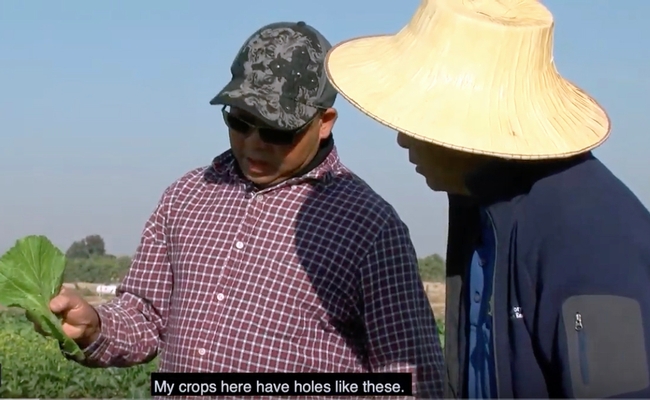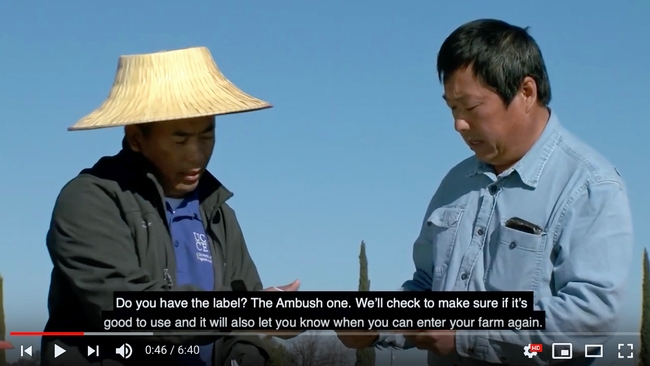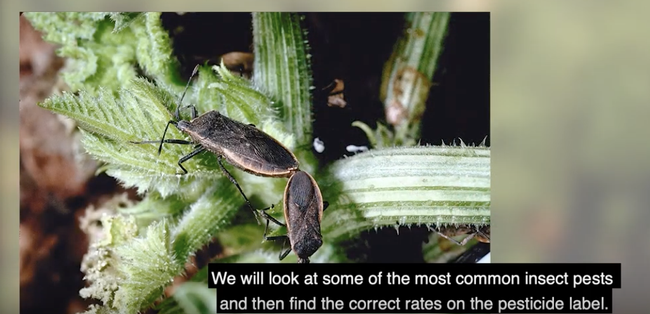
Posts Tagged: Hmong
Hmong-language pesticide safety videos now online
DPR, Fresno State and UCCE create pesticide safety videos with Hmong farmers
A series of videos describing California pesticide rules and safety in Hmong is now available to view for free online. The videos were produced by California State University, Fresno and UC Cooperative Extension in Fresno County with funding from the California Department of Pesticide Regulation.
The nine-part video series – Complying with Pesticide Laws and Regulations in California – is part of DPR's mission to reach California's farming communities. The videos cover a number of topics including using personal protective equipment, understanding pesticide product labels and application permit requirements.
The innovative educational tool blends peer-to-peer communication with traditional extension methods to include the knowledge and experience of both farmers and extension experts. Hmong farmers featured in the video helped develop scenes in which they educate other farmers, purchase and use personal protective equipment, and interact with extension staff.
“We worked with Hmong farmers who are following pesticide regulations themselves, and are now giving back to educate their peers,” said Ruth Dahlquist-Willard, UC Cooperative Extension small farm advisor, who collaborated on the video production. “Their voices and expertise helped make the scenarios more realistic and accessible to other farmers in the Southeast Asian community.”
Michael Yang, longtime UC Cooperative Extension small farms and specialty crops agricultural assistant, stars in the videos, interacting with farmers based on his extensive experience and trusted relationships in the Hmong farming community, and narrating the educational content in Hmong.
“We hope the videos broaden the reach of our local extension programming to help more farmers understand pesticide regulations and avoid fines, as well as improve their safe handling, selection and use,” said Yang.
Dahlquist-Willard and Yang plan to show the videos at UC Cooperative Extension meetings with Hmong farmers and distribute copies on flashdrives to county Agricultural Commissioner's offices in Fresno County and beyond. The videos are captioned in English.
“DPR works with all types of farmers on pesticide issues and it's critical that they use these tools safely – regardless of the language they speak,” explained DPR Director Val Dolcini. “This video project, the first of its kind to use Hmong speakers, will help foster safer use of pesticides.”
The videos can be viewed at http://bit.ly/fs-dpr-hmong-pesticide-video. The modules in the series cover:
- Introduction to California Pesticide Laws
- Checking for Crops Registered on the Label
- Pests and Application Rates on the Label
- Understanding Signal Words
- Following the Restricted Entry Interval (REI)
- Following the Pre-harvest Interval (PHI)
- Knowing Common Restrictions on the Label
- Using Personal Protective Equipment (PPE)
- Pesticide Permits and Reporting requirements
The project took 700 hours over 18 months to complete, including filming and post-production. Twelve Fresno State students were also involved in producing the videos with the Hmong farmers in Fresno County. Dahlquist-Willard and Yang provided the creative direction in partnership with the farmers involved, and Fresno State's MCJ Multimedia Production Service under Professor Candace Egan brought professional video production and editing skills to make a high-quality finished product. Fresno State student video editor Mali Lee, a fluent Hmong speaker, completed the final edits of the Hmong language material.
“This was one of the most rewarding projects I have ever worked on,” said project director Bill Erysian of Fresno State. “We brought together a unique group of agricultural specialists, students, farmers and video professionals to create a high impact, professional set of educational videos on pesticide compliance for our Hmong farmers here in California.”
DPR has comprehensive pesticide safety and outreach material available in Punjabi, Spanish and English at https://www.cdpr.ca.gov/docs/whs/worker_protection.htm.
Hmong farmers getting help from UC Cooperative Extension to weather the drought
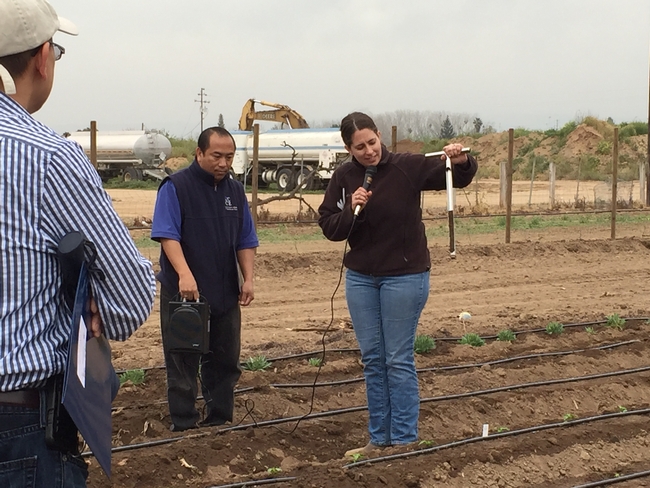
“Sometimes we don't see the farmers that often. They are busy on the farm,” Yang said. “But when they hear something (important) like this on the radio, they show up.”
UC Cooperative Extension office staff - including UCCE advisor Ruth Dahlquist-Willard, Yang, part time staffer Xia Chang, Fresno State student volunteer Sunny Yang, and research assistant Janet Robles from Fresno State's Center for Irrigation Technology – are working with small-scale and socially disadvantaged farmers one-on-one to line up the necessary paperwork and information to submit successful grant applications. (Read more about UC staffer Xia Chang, millennial Hmong farmer.)
“We helped eight farmers submit applications in the last two rounds, and seven received grants,” Yang said. “The money is significant.”
The grants allowed the farmers to make improvements in energy efficiency and water savings, Dahlquist-Willard said.
“This can make a huge difference for the profitability of a small farm,” she said.
The application requires energy bills from the previous growing season, a pump test and a plan for redesigning the irrigation system to result in reduced water use and reduced greenhouse gas emissions.
“There are a lot of calculations to do,” Yang said. “It's very complicated, and no one is available to help underserved farmers.”
While assisting farmers with applications for other programs is not usually part of UCCE's extension efforts, the small farms program in Fresno County has identified this form of assistance as crucial to the success of small-scale and minority-operated farms.
Help with the State Water Efficiency and Enhancement Program (SWEEP) grants is one in a series of outreach efforts for Hmong farmers spearheaded by Dahlquist-Willard since she was hired in 2014 to work with small-scale farmers in Fresno and Tulare counties. After just two weeks on the job, she was invited to an emergency meeting with the National Hmong American Farmers and USDA's Farm Service Agency to address the challenges faced by Hmong farmers as groundwater levels continued to drop during the drought.
“Wells were starting to dry up. Some Hmong farmers were reportedly calling suicide hotlines,” Dahlquist-Willard said. “We knew we had to take action.”
Dahlquist-Willard and her staff began researching programs that could offer the farmers financial assistance. They identified a free PG&E rate analysis, which could help the farmers choose the best electric rate for their irrigation practices to minimize charges. They searched for financing to deepen wells for farmers who had difficulty qualifying for existing USDA loans. And in 2015, they began helping farmers with applications for the State Water Efficiency and Enhancement Program.
The dire circumstances also prompted Dahlquist-Willard to commission a survey of Hmong farmers to see how they were impacted by the drought. Documenting their plight would be useful in seeking support. The survey was conducted in conjunction with outreach efforts with Fresno Regional Workforce Investment Board and Jennifer Sowerwine, UCCE Cooperative Extension specialist in the Department of Environmental Science, Policy and Management at UC Berkeley. The survey was funded with a grant from the USDA Office of Advocacy and Outreach and with support from UC Agriculture and Natural Resources via Sowerwine.
Sixty-eight farmers were interviewed by phone or in-person. Twenty-two percent said their wells had dried up, and 51 percent reported a decreased water flow.
“For the ones with dry wells, it could be $20,000 to $50,000 to drill a new well,” Dahlquist-Willard said. “A lot of them cannot get access to loans.”
To deal with irrigation water limitations, some farmers told interviewers they reduced acreage or changed the time of day they irrigate. Some stopped farming all together.
“One farmer told us he was irrigating his crops with his domestic well,” Dahlquist-Willard said.
Energy efficiency programs turned out to be very important for this population of farmers. Eighty-seven percent said their utility bills increased during the drought. As a result, UCCE has been promoting PG&E programs for energy efficiency as well as the SWEEP program.
The survey also showed the power of radio in reaching the Hmong farming community. Eighty percent of the survey respondents said they were regular listeners to Michael Yang's Central Valley Hmong Agriculture radio show.
Xia Chang: Millennial Hmong farmer
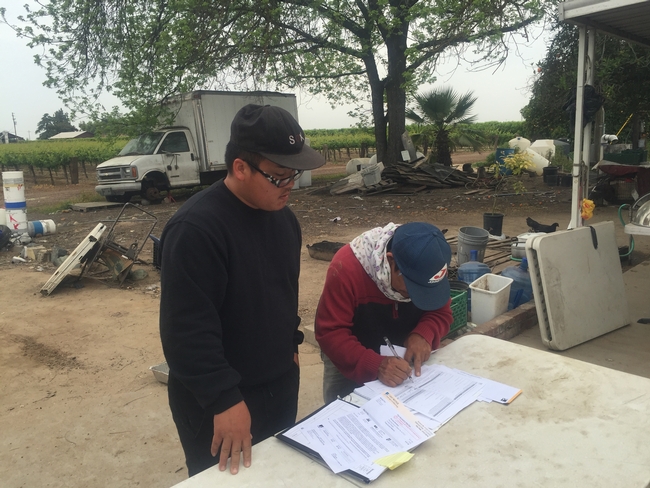
Chang attended college, but his financial aid was depleted before he earned a degree. In addition to part time work with UCCE, Chang is now farming.
“Last year we expanded our farm from 4 acres to 14 acres, with a new three-year lease,” Chang said.
The family's many technical agricultural questions led to Chang's frequent visits to the Cooperative Extension office, and ultimately to his being hired to help conduct the Hmong farmer survey.
“I spend a lot of time speaking Hmong on this job,” Chang said. “I've had to learn a lot of new vocabulary.”
He said he's also learning a lot about new farming techniques that he wants to apply on the family farm. However, there are obstacles.
“My dad is not open to new ways because he is afraid it would not be as successful,” Chang said. “But, in everything you do, you learn.”
Chang is now looking into a career in plant sciences. He is working with Dahlquist-Willard and Kent Daane, UC Cooperative Extension biological control specialist based at the UC Kearney Agricultural Research and Extension Center in Parlier, testing integrated pest management techniques in Southeast Asian vegetable crop production. In time, Chang plans to return to Fresno State to complete a degree in agriculture.
When vegetables become an adventure
Walking through a field lined with row upon row of different vegetables — many ready for the picking — can be an exercise in abundance. When you're faced with the prospects of a huge, just-picked Japanese cabbage or spicy green lo bok pulled fresh from the ground, suddenly vegetables might seem like less of a chore and more of an adventure.
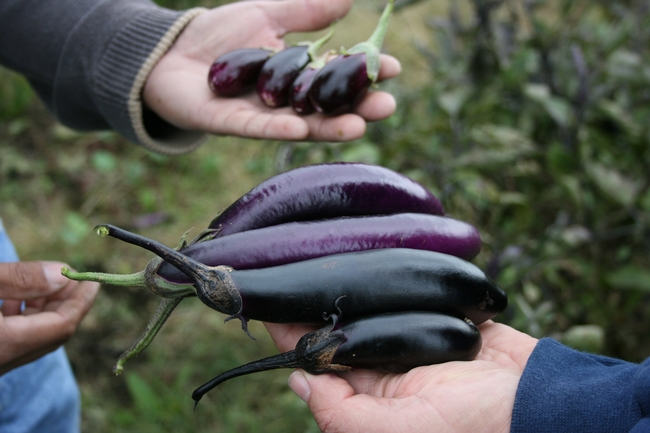
We were visiting the farm to share some new "veggie adventures" that went beyond the four colorful vegetables highlighted in this project (to refresh your memory, the Great Veggie Adventure highlighted Romanesco, rainbow carrots, party cauliflower and watermelon radishes).
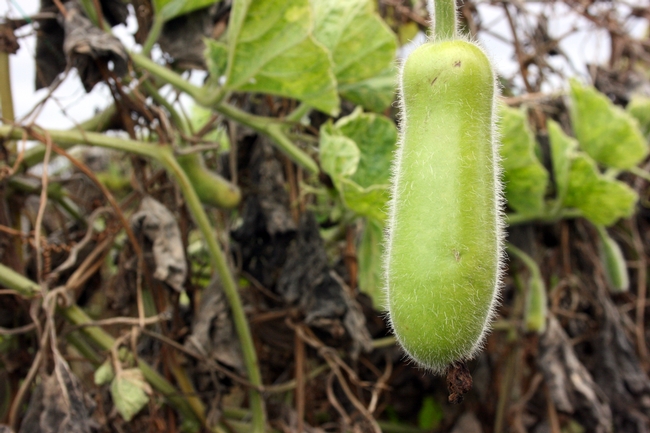
Molinar and Yang showed me many vegetables I had never tried, including moqua, sinqua, long beans, lo bok, opo and winter melon.
"One of the exciting things about this job is you always learn something new," Molinar said. "Our specialty is with the Asian vegetables, with Michael's expertise in that area. Asians have vegetables that are unique to their culture, that they prefer — just like Punjabis have vegetables unique to their culture, and Hispanics have vegetables common to them."
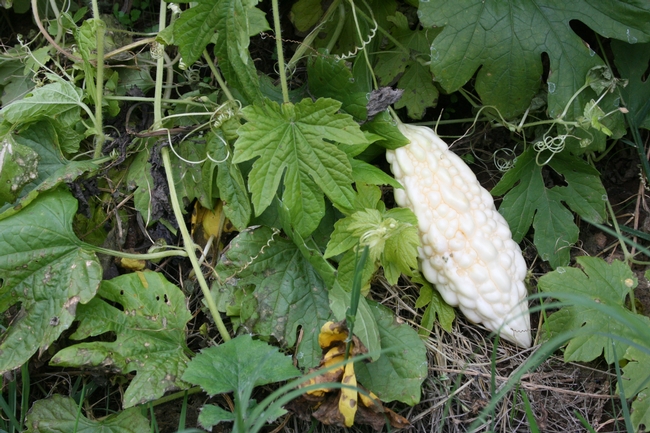
We walked between the trellised crops and up and down the plant rows, while Yang and Molinar picked samples and talked about how to eat these new-to-me vegetables.
Yang pointed out that sometimes Asian vegetables include familiar varieties that are grown and eaten in less familiar ways. For example, many Hmong and Chinese farmers grow sugar snap pea plants for the tender shoots, tendrils and leaves instead of the pea pod.
Make sure to watch our short video from that day:
Still curious?
- Find more information about growing Asian vegetables from the UC Small Farm Program
- Visit the official Great Veggie Adventure website by the makers of Hidden Valley Salad Dressings
- Watch more videos from our Great Veggie Adventure playlist
Put down that zucchini! Pick up the ... bittermelon?
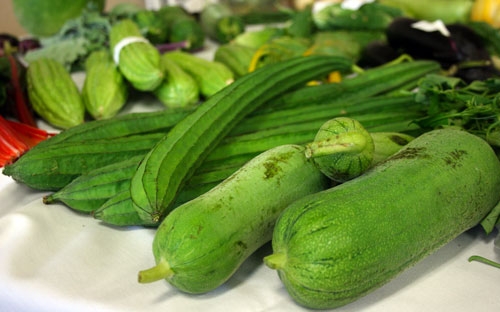
Welcome to August. Are you tired of summer squash yet?
If your dinners have been overflowing with zucchini recently (like mine have), now might be a great time to try new varieties of otherwise familiar vegetables.
One of the farm advisors I work with has long touted some varieties of "Asian vegetables" as more flavorful than their traditionally "American" cousins. Here in the U.S., vegetable varieties like these are more likely to be grown by farmers — and sold to customers — who have close ties to Asian immigrant communities. Richard Molinar, UC Cooperative Extension farm advisor for Fresno County, works frequently with Hmong farmers and says that he now prefers Hmong cucumber and Japanese eggplant to the varieties you might find in most California supermarkets.
After years of hearing Molinar's claims, I finally had a chance to try some of these new-to-me Asian vegetables during lunch at the Hmong Specialty Crops and Medicinal Herbs conference.
Presenters in the morning talked about crops such as sinqua, luffa (photo above has fresh luffa, in angled and smooth varieties), moqua, snake gourd, bittermelon and donqua — all of which are cucurbits, in the gourd family with other squashes and melons. Other Asian vegetables common in some specialty markets include leafy greens and tender shoots from chayote, amaranth, bittermelon, pumpkin, okra leaf, yam leaf, yucca and sour leaf plants. Discussions at the conference focused on these and other specialty crops, including ways to eat them.
"Maybe we need a recipe to teach customers how to buy these new crops," said Chukuo Thao, CEO of National Hmong American Farmers, who alternated between English and Hmong while speaking at the conference.
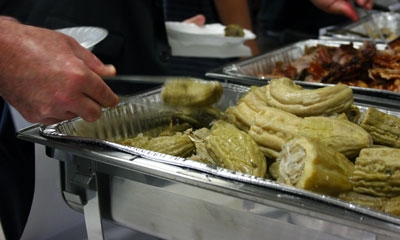
Some of the vegetables and herbs discussed at the conference were highlights of that day's lunch. The menu included a slushy Hmong cucumber drink, purple sticky rice, salsa made with cherry tomatoes, stir-fried mustard greens with pork skin, Hmong herbal chicken soup and steamed bittermelon stuffed with turkey.
But how did it taste? The stuffed bittermelon was what I was most looking forward to trying. The dish was delicious and wow, was it bitter! That is one appropriately named vegetable. Speakers at the conference suggested bitterness is frequently associated with medicinal qualities in Hmong cuisine.
Not all of the lunch dishes were bitter, of course. The cucumber dish was refreshing and very sweet, a dish with eggplant was spicy, and the mustard greens were salty and pungent. Many of the dishes were also made with lemongrass; Fresno County is where most of the nation's lemongrass comes from, according to Molinar in a recent article from the California Ag Network.
Curious about other Asian vegetables? Check out the Small Farm Program's guides to Asian vegetables, along with tips for farmers about how to grow and sell these niche varieties.
Question: The Small Farm Program has a lot of information about different vegetable varieties, but I'm still finding new vegetables to try. What are some of your favorite Asian vegetables?
P.S. While the conference was my first chance to taste bittermelon, Richard Molinar and Gus Schumacher (former USDA undersecretary) were being honored by Hmong community members for their long-time support of Southeast Asian refugee farmers. The two men were each given Hmong names in a special ceremony.
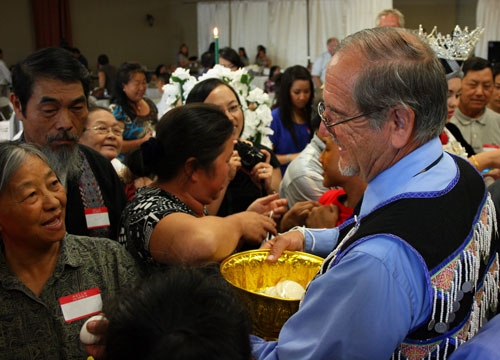
Upscale magazine celebrates Hmong cuisine
A brief article in this month's issue of San Joaquin Magazine gave readers a glimpse of one of the more unusual research plantings at the UC Kearney Research and Extension Center by UC Cooperative Extension small farm advisor Richard Molinar and his assistant Michael Yang.
The publication, which the title page claims "is found in affluent homes of Stockton, Lodi, Tracy, Ripon, Manteca, and Mountain House," said "evocatively-named" herbs Siberian motherwort, Vietnamese coriander, Black nightshade and Jewels of Opar and others are grown in the UC "garden" to celebrate Hmong culture.
"We want to enlighten people about these herbs," Molinar was quoted in the story.
Yang, an immigrant from Laos, explained that the preparation of chicken soup has a special significance in Hmong kitchens.
"We prepare a bundle of at least five different herbs, usually including such herbs as koj liab and pawj quaib, and simmer in chicken soup stock. It is a common practicie for Hmong women to drink this soup for the first month after they give birth," Yang was quoted.
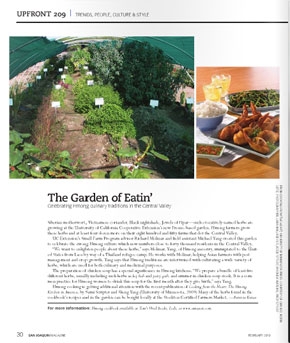
San Joaquin Magazine.

